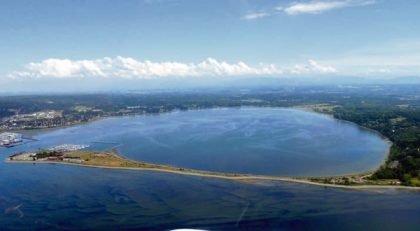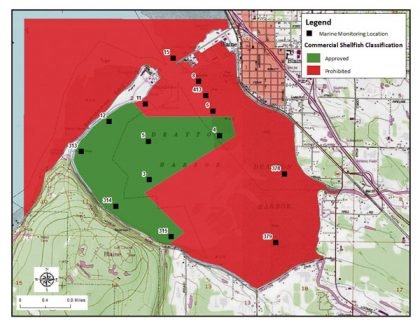By Stefanie Donahue
Two decades of commitment to improve water quality in Drayton Harbor has finally paid off – last week, recreational and commercial shellfish harvest restrictions were lifted on 810 acres of the harbor.
The Washington State Department of Health made the announcement last week after tests revealed improvements to water quality. For more than 20 years, state and county agencies, nonprofit organizations and volunteers have worked to reduce high levels of fecal coliform in the water that have restricted harvesting as far back as 1995.
 Photo courtesy of Whatcom County Public Works.
Photo courtesy of Whatcom County Public Works.
To celebrate the occasion, the public is invited to gather at Drayton Harbor Oyster Company at 4 p.m. on Friday, December 16 to enjoy fresh oysters. The restaurant is located at 677 Peace Portal Drive in downtown Blaine.
“I have been farming oysters in Drayton Harbor since the mid-1980s and have fallen in love with the place,” said owner of Drayton Harbor Oyster Company Steve Seymour in a statement on December 1. The family-owned eatery farms oysters in the harbor to source their product.
“Today’s news is about a community which shares this appreciation and has been a willing partner in preserving this magic place for the next generation,” he said.
Drayton Harbor saw its first commercial oyster farm crop up more than 100 years ago. Before pollution slogged its way into the waters, the Lummi Nation harvested as many as 30,000 clams per year in the early 1990s.
Long-time player in the effort to improve water quality in the area, Geoff Menzies, described the work to revitalize the harbor as laborious, but not futile. Menzies and Seymour partnered to cultivate oysters in the harbor in the years leading up to its closure.
It started in 1995, when Drayton Harbor was partially closed to shellfish harvesting due to high levels of pollution, making consumption of shellfish unsafe. In 1999, the harbor was closed entirely.
 Last week, the Washington State Department of Health lifted harvesting restrictions on 810 acres of Drayton Harbor. Station 4, pictured left, was re-opened for commercial harvest and the shoreline that runs along station 11 to 315 was opened to recreational harvest. Photo courtesy of Whatcom County Public Works.
Last week, the Washington State Department of Health lifted harvesting restrictions on 810 acres of Drayton Harbor. Station 4, pictured left, was re-opened for commercial harvest and the shoreline that runs along station 11 to 315 was opened to recreational harvest. Photo courtesy of Whatcom County Public Works.
Closures have continued sporadically through the years. In 2004, the harbor reopened under specific approval conditions and required a five-day closure if 0.5 inches of rain fell within 24 hours, said Whatcom County senior water quality planner Erika Douglas.
Closures were reduced in 2006, when .75 inches of rainfall in 24 hours became the new benchmark. Seasonal restrictions followed in 2010, imposing harvest closures from November through February. Starting in 2013 and until last week, the closure spanned November through January, she said.
Early harvest restrictions in the mid ’90s spurred the establishment of the still-active Drayton Harbor Shellfish Protection District advisory committee. For more than 10 years, Menzies chaired the volunteer committee which worked to improve water quality and restore shellfish harvesting.
A number of hands came together to support the initiative, including the Puget Sound Restoration Fund, which is credited with spurring volunteer restoration efforts in the harbor. The organization is responsible for launching the Drayton Harbor Community Oyster Farm, which was managed by Menzies and maintained by other volunteers and community partners. In 2004, it cultivated the first commercial harvest since the partial closure in 1995 and was later transformed into a commercial operation by Seymour.
Outreach efforts led to the monitoring of 3,000 on-site septic systems located within the watershed, Menzies said. Small hobby farmers within the watershed were also approached about containing livestock waste, he said. Boat owners were also cautioned from directly discharging waste into the harbor.
Looking ahead, he admits the work must continue.
“I think we’re at a critical point now,” he said. “We need to continue to be vigilant and make sure that we don’t lose it again.”
Shellfish harvesters are encouraged to “check before you dig.”
To get the latest on harvest restrictions, visit doh.wa.gov/shellfishsafety.
Comments
No comments on this item Please log in to comment by clicking here